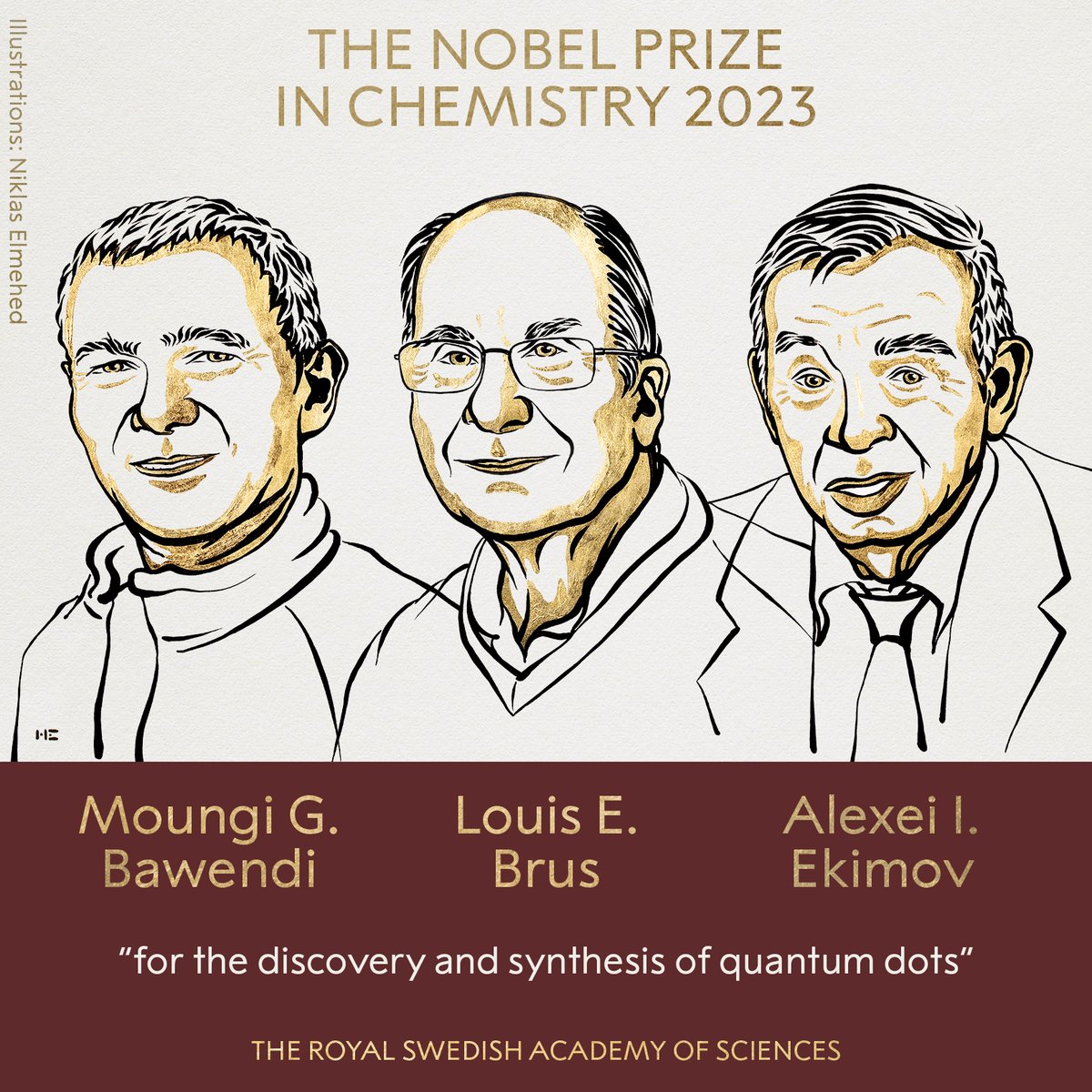Prof Homendra Naorem
The Royal Swedish Academy of Sciences, founded in 1739, has in clock like regularity announced that the Nobel Prize in Chemistry for 2023 would be awarded to Moungi G. Bawendi, MIT, USA, Louis E. Brus, Columbia University, USA and Alexei I. Ekimov, Nanocrystals Technology Inc., USA for the discovery and synthesis of quantum dots – a class of nanoparticles so tiny that their size determines their properties. Though the word ‘Quantum’ is well accepted among the general public, quantum dots unlike dot com (.com as in IT) are rarely heard of, let alone terminologies like quantum theory, quantum effects, quantum world, etc. What exactly are these quantum things and their significance to a layman?
The 20th century perhaps dawned with the quantum theory and quantum world – a world made of electrons, protons, neutrons and other smaller constituents where every small bit of action is given by the product of its energy and time so long as the product is less than the Planck’s constant. Initially, there were very few takers of the quantum theory until almost all the then unexplained phenomena like black body radiation, photoelectric effect, absorption and emission of light, the heat capacity of solids, etc. were one by one rationalized in the light of the quantum theory. The quantum world operates at atomic or even smaller scales and at this scale, things do not behave the same as the objects on the scale that we can see and perceive which makes the quantum theory defying common sense! For example, common sense implies that an unarmed person kept confined in a room with strong iron walls will never be found outside of the room unless the person is physically released, but if an electron is confined in a similar room or box (of atomic scales, of course), there is a finite probability that it can be found outside the box anytime (quantum tunnelling)! Despite so many inconceivable results and predictions, quantum theory continues to flourish giving birth to many new discoveries, inventions, technologies, etc. Quantum theory largely operates on the concept of ‘probability’ rather than ‘certainty’ which led Einstein at later stages sceptical of the theory as reflected in his infamous quote, ‘God does not play dice’.
The smallest unit of matter called molecules are made of atoms whose constituents are electrons, protons, neutrons, etc. known as the elementary or the quantum particles which are best understood through the prism of quantum theory. All the matter and everything we see and experience emerges from these invisible quantum particles in their infinitesimal realm with all the mystifying effects in their weirdness. What happens when the size of the matter becomes smaller? Will they continue to behave the same or contrarily? The size (radius) of an atom is about 0.1 nm (1 nm=10-9m) and the nucleus is about 10-6 nm. When the size of the matter is reduced to less than 100 nm, matter begins to show unexpected properties giving birth to nanoparticles, nanomaterial and nanotechnologies. The unique properties of the nanomaterials or nanoparticles are generally attributed to their size and more importantly to their high surface area to volume ratio.
Properties of atoms are largely dictated by the electrons present in their outermost orbital – the so-called valence electrons – which roughly is the principle on which the modern periodic table is based. When these electrons under the influence of the nuclear potential are confined within a tiny space, they start behaving abnormally giving rise to what is known as the quantum effects like restricted or quantized motions, uncertainty in their position and momentum, etc. The quantum effects exhibited by the quantum particles like electrons are perhaps due to their forced confinement within the tiny space with boundary conditions (restrictions) rather than the size alone since electrons would begin to behave normally once released (ionized) from the confinement. Like a person kept under house arrest or solitary confinement beginning to behave differently like a man possessed, electrons when confined within the nuclear potential also begin to behave abnormally, if you like. Reducing the space available for the electronic motions to atomic scales increases the energy gap between its quantized energy states or, in other words, as the size decreases the energy gap will become wider requiring more energy for the electron to jump around resulting in absorption or emission of light at a higher frequency and hence, a change in its colour – an effect known as blue shift. The optical and other luminescent properties of the matter will thus become size dependent sowing the seeds of Quantum Dots! Quantum dots are nanoparticles of single nm dimension usually made from semiconducting materials such as metal sulphides or halides which are capable of showing profound quantum effects with their electrons confined inside the dot (the nanomaterial) through blue shift effects. It should, therefore, be possible to develop tiny nanomaterials whose optical and electrical properties can be tuned by tuning their size. But it had largely remained at the conceptual level until the development of such materials. Who else can develop such materials better than a Chemist!
In 1981 the Russian physicist Ekimov reported in a Soviet scientific journal that the colour of the glass when tinted with copper chloride can be changed simply by changing the size of the tiny crystals of copper chloride tinted in the glass by heating it at different temperatures. The results were just unbelievable – the colour of the glass simply depended on the size of the particle in it or the same particle giving different colour – a clear case of split personality! This had remained largely unnoticed on the western side. Around this time, oblivious of the works of Ekimov, Brus and his group including Bawendi (as post-doc fellow) while working at Bell Labs to use solar energy to initiate chemical reactions using cadmium sulphide (CdS) nanoparticles floating freely in a fluid observed that the optical properties of the CdS nanoparticles were size-dependent. They used CdS nanoparticles to absorb light which can be harnessed to drive chemical reactions. In order to provide a larger surface area on which the chemical reactions can take place they need to make the particle as small as possible, because the smaller the particle larger its surface area. Both Ekimov and Brus, therefore, had not exactly attempted to synthesize or develop quantum dots but they accidentally stumbled onquantum dots while working on nanomaterials but with different perspectives. However, the methods they used to produce the quantum dots generally resulted in particles of varying sizes and often with defects. This hindered the development of the quantum dots and their commercial exploitations. Everyone including the Chemist Bawendi who started his postdoctoral training at Brus’ laboratory was working on the development of new reliable methods for producing good quantum dots. It was just not forthcoming.
Not deterred by the failures at Bell Labs, Bawendi after joining as a research leader at MIT still continued his efforts to synthesize higher-quality quantum dots. It was only in 1993 that he came out with a major breakthrough in the synthesis of quantum dots known as the ‘rapid injection method’. When his research group injected the substances that would form nanocrystals into a heated and carefully chosen solvent by injecting as much of the substances as was necessary to precisely saturate the solution for the tiny crystal embryos to begin to form simultaneously. This new path-breaking method made it possible to develop quantum dots of a specific size with smooth and even surfaces by dynamically varying the temperature of the solution. The quantum dots thus produced were almost perfect giving rise to distinct quantum effects. Because of the ease with which precise quantum dots can be produced, more scientists started investigating the unique properties of quantum dots – the Bawendi method is indeed truly revolutionary. In fact, it is Bawendi’s high-quality ‘rapid injection method’ of production of perfect quantum dots that paved the way for their wider commercial and medical application. It has already revolutionized from LED (Light Emitting Diode) or OLED (Organic-LED) to QLED (Quantum dot LED) in display monitors or smart TV screens, etc. Now one can have Core type Quantum dots (CQDs) of single component materials with uniform internal compositions, or Core-Shell type Quantum dots (CSQDs) in which small regions of one material are embedded in another with a wider band gap, or Alloyed Quantum dots (AQDs) in which two semiconductors with different band gaps are alloyed which showed both composition and size-unable properties. Since the properties of matter are now shown to be size dependent, the properties of matter are not only a function of its valence electrons but also its size – requiring a revisit of the principles of the Modern Periodic Table!
Quantum dots are certainly not the last word in the quantum world, the next in the line perhaps is the Quantum Computers which are based on qubits (quantum bits) that can exist in multiple states simultaneously due to the quantum superposition principle rather than bits (binary digits) in the so-called classical computers where everything is in either 0 or 1 state. For example, a coin can exist as Head or Tail state only but in quantum computer the coin can simultaneously exist in a superposition of both Heads and Tails states. Quantum computers can compute exponentially faster with enormous variables with enhanced capability for solving much more complex phenomena.
While the Chemistry Nobel 2023 is on the development of matter at a much smaller length scale, the Physics Nobel Prize 2023 is on the development of a much smaller time scale, Agostini, Krausz and Huillier developed experimental methods that generate attosecond (10-18 s) pulses of light for the study of electron dynamics in matter. Femtosecond (10-15 s) was once considered as the limit for the flashes of light it was possible to produce and now it is attosecond – the timescale at which the properties of an electron change! Will there ever be a limit to human imagination and the run for chasing imagined situations!
The 2023 Nobel Prize for Physics and Chemistry perhaps is sending a subtle message to switch from the age-old cliché ‘Think Big’ to ‘Think Small and Remain small’ and one should not grow older and become ‘Wider and Weightier’ like many of us do consciously or otherwise. Bulky groups, as they say in organic chemistry, are good leaving groups and why should one be in a hurry to leave the universe earlier than expected? One should grow older and become ‘Wirier, Wiser and Wealthier’ leisurely looking forward to quantum effects to set in!
The writer currently serves as a Professor in the Chemistry Department, at Manipur University.
The statements, views and opinions expressed in this column are solely those of the author and do not necessarily represent those of the NEA. The credit for the image goes to the original owner and The North East Affairs does not claim the ownership and/or the infringement.


